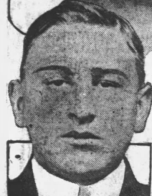 The Buffalo Times, April 19, 1923 On the night of January 24, 1922, four men entered Alexander Dombrowski’s farmhouse in Brownstown, Michigan, about 20 miles southwest of Detroit. The men falsely claimed to be federal officers raiding the house for liquor. Dombrowski – a farmer and alleged whiskey runner – resisted the men’s search efforts, grabbing a knife and cutting one man on the hand. After a struggle, that man shot Dombrowski four times, and another man also pulled a gun. Dombrowski died the next day.
In July 1922, 25-year-old Leo Sauerman was arrested on an unrelated crime, and police noted a scar on his hand in approximately the place where Dombrowski’s wife said Dombrowski had slashed the shooter. Dombrowski’s wife, their 11-year-old son, Leonard, and two other witnesses identified Sauerman as the man who had struggled with and then fatally shot Dombrowski.
Sauerman’s trial began October 2, 1922, in the Wayne County Circuit Court, with Judge Joseph A. Moynihan presiding. Dombrowski’s wife and son testified, each identifying Sauerman. The jury found Sauerman guilty of first-degree murder on October 6, 1922. When the judge asked Sauerman if he had anything to say before sentencing, Sauerman said, “I am innocent of the crime. I was in Kalamazoo the day it was committed.” Judge Moynihan sentenced him to life in prison.
After Sauerman’s conviction, his sister, Helen Bauman, pressed police to continue investigating, as she believed in her brother’s innocence.
In December 1922, known bootleggers Melvin Brown and Homer Noel confessed their involvement in Dombrowski’s murder to Detroit Sheriff C.J. Coffin. Both men claimed that a man named Harry Hill was the shooter, and that Leo Pakizer had been their other accomplice. Brown and Noel said that Sauerman was not involved. Police began investigating this claim.
Officers contacted May Francisco, who ran a boarding house in Detroit and had been renting a room to Noel at the time of the crime. When initially speaking to investigators, Francisco denied having information about the crime. However, Wayne County prosecutor Paul W. Voorhies came to speak with her. He said that Noel and Brown had confessed and implicated a man named Harry Hill, but that police and prosecutors were skeptical as to Hill’s existence. At this point, Francisco admitted to knowing Hill and having information about the murder.
Francisco told Voorhies that, in addition to renting to Noel, she had been renting a room to Hill from early January 1922 through March 1922. She said that Hill left her house around 8:00 p.m. the night Dombrowski was killed and did not return until morning. On his return, Hill’s hand was bleeding, and Francisco said she saw him throw away a bloody glove. She said that Hill realized she was watching him and told her he would kill her if she told anyone what she had seen. She said that Hill stopped by her boarding house months later and told her that Sauerman had been arrested for the crime. He repeated his threat that he would kill her if she told anyone about his involvement in the murder.
Francisco provided an affidavit with this information in March 1923.
Notwithstanding Noel’s and Brown’s statements and Francisco’s affidavit, Judge Moynihan declined to reopen Sauerman’s case, reiterating his belief that Sauerman was guilty. Sauerman’s attorney, Edward N. Barnard, filed an appeal with the Michigan Supreme Court, but available records do not provide further information on this appeal.
On January 22, 1923, Noel pled guilty to second-degree murder in Dombrowski’s death. Brown also pled guilty to second-degree murder two days later.
In April 1923, police arrested Pakizer and charged him with murder upon his release from jail for an unrelated crime. His case went to trial in June 1923. The prosecutor called Noel and Homer to testify. Noel refused to testify, saying “I have nothing to say. I have been convicted, and as far as I’m concerned, I’m through with this case.” Homer, too, refused to testify. Pakizer was acquitted.
In November 1924, police located and arrested Hill in Chicago, Illinois.
Hill’s trial for Dombrowski’s murder began in April 1925. Francisco testified for the prosecution. Homer and Noel again refused to testify. On May 1, 1925, a jury found Hill guilty of Dombrowski’s murder.
Less than an hour after Hill’s conviction, Michigan Governor Alex J. Groesbeck pardoned Sauerman. On issuing the pardon, Groesbeck released a statement, which read in part: “This pardon is issued because a most careful and prolonged investigation left no doubt in my mind that Sauerman was not guilty of killing Mr. Dombrowski.”
- Meghan Barrett Cousino |